The topic of this one has occurred to me several times before, and I think I avoided it because I consider it a cakewalk, a facet that’s all too easy to explain. And yet, there are a lot of people who put great stock in it, never seeming to view it with any form of critical appraisal, so let’s go ahead and look at some answers to the question, “But if there’s no god, how do you explain revelation?”
Naturally, by this is meant religious revelation, and not the sudden realization that Spongebob Squarepants is an homage to Hemingway. A very large number of religious folk credit some form of revelation or another as evidence of god, and there are a wide variety of experiences that they relate in support. I won’t be able to address every variety of course, which will leave the opening that is used so often, not just over religious topics either: you didn’t disprove this one, so it counts as proof. That’s not at all how logic works, but it does demonstrate the bias that underlies so much of belief (and again, not just religious belief.) Despite all that, let’s see what can be found to answer the question anyway.
The first point that I’ve always made, that no one has ever seen fit to respond to, is how all religions have their adherents who claim revelation, now and throughout history. Given the diversity of faiths, including the outright contradiction among many, we have three potential explanations: that revelation is false for all others except mine (the standard, yet unvoiced, belief); that god is fine with whatever faith anyone already has (making any distinction at all completely pointless); or that revelation is just wishful thinking. And while it would certainly be useful to rule out the last one to give any weight at all to the existence of a supernatural being, very few ever seem to expend the slightest effort in this regard. With a certain amount of snarky delight, I will point out that no one has disproved that revelation is nonsense…
Let’s not abandon this aspect yet, because there are a few ramifications to be considered here. Revelations are usually not just a matter of someone being affirmed that their faith in jesus/muhammad/moses/krishnu/ra is correct, but that there is a particular set of actions that they should be taking, and these have ranged as widely as, ‘spreading the good word,’ to, ‘beheading the infidels.’ When extremism rears its ugly stupid head, many of the devout are very quick to distance themselves, even defining what the True™ religion is – but if these actions were dictated by revelation, what then the value of revelation? Holy wars throughout history have been the clash of devotees who believe they have divine authority – that’s pretty much what defines a holy war. Yet all sides cannot be guided by divine information, unless god is intentionally setting up human fights, and again, what purpose would religion serve then? There should be some useful way to determine that revelation is more than simply ego.
There are definitely some things that we should expect to see, if god had any contact at all with mankind in such a manner: an undeniable tendency towards the one, true religion; a lot of people switching faiths; a notable tendency for those of a certain faith to accomplish more, or maintain a better overall quality of life – some benefit, anyway; and perhaps some unquestionable avoidance of dire consequences, courtesy of divine forewarning. Hell, couldn’t we even see some examples of scriptural clarification, where some debated (or badly misinterpreted) passage becomes crystal clear? Yet none of these are in evidence. The number of adherents, the percentages of populations displaying any given faith, vary widely throughout history, with a distinct downward trend for all of them right at this moment (and certainly no steady increase for any.) No one faith can be said to be in better condition, regardless of measuring method, and in fact, several polls in the US at least have shown that religion tends to be strongest in areas of the poorest quality of life – more on this in a second. It’s usually not to hard to find individual examples of people who had a premonition and avoided some situation that might have killed them, such as not getting on a flight that crashes, but this happens routinely even without any premonitions. And just to harp on this aspect a bit, why is it a miracle if someone survives an accident that was fatal to dozens or hundreds of others? Are we to believe this one person was that special? Could you show us how, please? It should be impressive…
Let’s look at the idea of numbers a bit closer. While there are a very large number of people who credit their own revelations, there really aren’t many at all that have switched religions over it, are there? No matter how you look at it, the majority of religious folk in the world have to follow the wrong religion, since not one religion possesses a majority throughout the population – and this is using the broad categories of christian and muslim and such, ignoring the myriad sects within that bicker amongst themselves over who follows the right version. While I know of no source that tallies how many people switched faiths due to revelations, the Pew Report lists 28% of Americans that have “left the faith in which they were raised in favor of another religion – or no religion at all” – it’s probably safe to say that those dumping religion were not following god’s recommendation in that regard. Of the remaining, it was primarily a lateral shift within christianity, with catholicism taking the biggest hit – feel free to speculate on how much of that was due to the reprehensible attitudes the catholic church has been displaying recently.
Even if we assume, just for a data point, that those who converted to evangelical protestantism did so at the urging of god, this still means that everyone who converted to something else, as well as everyone who stayed put in any other faith because their revelation simply confirmed their position, is wrong. The numbers aren’t being kind, to either any particular religion being correct nor to revelation having any value. Again, most religious folk seem to have no problem with believing that everyone else has it wrong, and never tumble to the conclusion that it must be ridiculously easy to be deluded in this respect. But of course this could not possibly happen to me.
Let’s backtrack a bit, and ask what revelation actually is. 99.9999% of the time it’s strictly personal, an experience that no one else has, so of course, we’re supposed to take anyone’s word for what happened – you can see where some problems might arise with this. In fact, it is so ludicrously easy to fake revelation that one might think some ground rules should be in place, some basic standards to differentiate. Feel free to look around and see if anyone, ever, has bothered with this. It’s almost as if nobody cares whether the experience is genuine or not – and, really, that’s what we see. If someone else’s revelation confirms our beliefs, then that’s good enough to be considered genuine, and if it denies them, well then it must be false. But let’s not undersell it either, because such experiences are not related nor responded to with any level of indifference, as if someone finally watched an episode of Dr. Who last night. No, revelations are generally considered quite important, life-changing in fact, and unsurprisingly there is a certain status to being someone to whom god communicated directly, better than receiving a call from the President.
Having set that up, I’m going to surprise a few people by saying that I’m not making a case that most revelations are intentional deceit, because I don’t really believe that myself. Yet there is a strong positive aspect to having a religious revelation, with little negative potential as well, and of course no real bars to clear. Worse is that god is no longer, apparently, doing much in the way of physical manifestations, and has a magical realm to spend time in, so no one really expects such contact to be in writing, for instance, or even a figure appearing in a puff of smoke. No, it’s all in the head – that sounds sarcastic, but it’s not wrong either, is it? When physical manifestations do occur, it is almost always in the manner of a “sign,” and this can be nearly anything.
Once again, I don’t have any figures to throw out in support of this, so all I can do is pose the question: how often are revelations and signs asked for in the first place? How many have come hard on the heels of the desperate desire for a response? How many communications occur when someone finds themselves confused, anxious, depressed, or disillusioned? You remember that point above about religion tending to be stronger in areas with poorer conditions – just how are they related? Or to be more specific, exactly how much of it is because people with few other options find it necessary to appeal for help from a higher, beneficent being?
Such situations become ripe for confirmation bias. It’s easy enough to have a dream about something that presses on our minds constantly, but when it’s religious in nature, how often does this automatically become that sign, that revelation, that confirmation that everything is going to work out? (I have apparently been told, on several occasions, that I’m going to end up in school in my underwear, late for class because I can’t figure out my schedule – it hasn’t happened yet but it’s going to, I’m sure.) How often does a strange pattern in a tree trunk, in a cloud, on a grilled cheese sandwich, become a message because it bears some vague resemblance to someone whose appearance was never recorded, only guessed at by artists? Consider how many things that we encounter daily that can be interpreted as something more, something transcendent or even just remarkably odd, as long as we’re inclined to try and find such things in the first place.
The immediate argument that arises is the emotional one. It must be important, so we’re told, because of the feelings behind it – these wouldn’t occur for any normal situation. So sure, let’s examine this aspect. You’ve probably heard of Beatlemania, the name of which was cribbed from Lisztomania, and are well aware of people losing their minds and even passing out because of the supernatural power of three guitars and a drum kit, right? Consider meeting with a favorite celebrity – how, exactly, is this different in any way from meeting anyone else in the world? Sure, maybe they’re more attractive than average, but is that really enough to provoke such overwhelming feelings? How about the people who get a rush when they see a famous painting for the first time in person? Chances are, the view is considerably much worse than their previous experiences with photos and printed depictions of the exact same work, but the emotional effect doesn’t exactly reflect that, does it? In such cases, it’s not the impact on our exterior senses that has anything at all to do with it, but the perception that we have internally. In other words, we’re emotional because we think we should be. And yes, the mind is perfectly capable of controlling the body to such an extent. Note, this is just over La Gioconda or Hannah Banana or whatever – imagine if we believe we’re meeting god.
When I was in my late teens, I had a dream that I was shot in the chest at close range by a masked assailant. I immediately awoke, but lay in bed motionless for a long time, trying to get my psyche (and pulse rate) back under control. There was no question that it was all in my head, a simple nightmare, but the emotional effect was devastating, true horror, and difficult to get over – and note, this was a negative effect that I had no desire to maintain. We can, very easily, be manipulated by our minds, and ‘meaning’ is entirely up for grabs. We can even have a deep emotional reaction to something undeniably trivial, and it happens frequently, the source of so many of those remarkable (usually non-religious) revelations right before awakening, but also provoked by various pharmaceuticals of questionable legality. Now consider if we’re particularly religious, and have a dream of powerful emotions that not only involves a god, but somehow promotes our self-worth – how inclined are we going to be to tell ourselves it’s just a dream?
Now let’s look at environment. Part of the function of churches (probably most of the function) is to maintain an exclusive, self-supporting environment that reinforces certain manners of thinking, exploiting our tendency to take our cues from others around us. It is hardly going to be surprising that any church that speaks favorably of revelations is far more likely to have them spontaneously appear among members of their congregation, yet this isn’t even necessary. Such things are openly recognized in many cultures (including all those heathen ones,) and the idea of visions, spiritual journeys/pilgrimages, and divine messages has been around for centuries, predating many forms of scripture as well – even this blog title has a distant connection to the idea. We’ll actually pay to have our photos taken with a celebrity, just for the prestige and superficial implication that yeah, we hang out with such higher beings; it’s not a stretch to think that the desire for divine recognition is capable of fudging objectivity to no small degree, saying nothing of those who really would lie about their experience just for the status.
So hopefully, we’ve established that being mistaken about a revelatory experience is exceptionally easy, especially if someone favors the idea in the first place, and it’s even easier to claim to have one. That brings us to the concept of trying to distinguish true revelations from false – again, something that few if any religious folk ever attempt in the first place. So we might ask by what method we could determine the veracity of a personal vision or experience? Obviously, some form of information that isn’t available through any other means, or that supports divine intent at least. How often does this occur? Are there even any events recorded throughout history that demonstrate this to any objective degree? Joan of Arc is perhaps the most well-known of those who acted on their divine communiqués; she was apparently told to repulse the English invaders, which didn’t happen, and achieved martyrdom because she’d been executed after a corrupt trial (and of course, one must ask what god had against the English, and why this event required the intervention?) Was that divinely important? Are there better examples that can be found? Because the religious revelations seem to be faring poorly, compared against scientific ones: Copernicus, Kepler, Einstein, Maxwell, Darwin, Pasteur, Faraday, Bohr, Mendeleev, et cetera et cetera. All of these contributed undeniable and overwhelming advances to our knowledge, our cultures, and our technology and standards of living – and without the demarcations of religion, mind; the revelations are as powerful and equally applicable to buddhists, sikhs, or rastafarians. Anyone is welcome to credit these to god – it’s happened numerous times before – except that this not only trashes the value of religious revelations that urge us to accept jesus into our heart to get over alcoholism, many of these scientific revelations were instrumental in proving scripture wrong and weakening the faith in god’s word overall, so, yeah…
“But you don’t understand,” say the faithful, “god is not here to prove himself to us. He provides help when it is needed.” Or some variation thereof – it’s amazing how many people know what’s going on but somehow never agree with one another. This protest allows for the personal, you-should-do-missionary-work kind of revelations that so many confess to having, which really isn’t evidence of divine intervention at all, nor really a lot of use, especially when compared to how much has been accomplished by those scientific revelations above – is the argument really that god is that ineffectual? Are we to believe that, faced with introducing the concept of germs to mankind a few millennia before we got around to finding it out on our own, or perhaps halting several hundred different slaughters by appearing to some megalomaniacal leaders and saying, “Listen, you little shit,” a supreme being instead chose some urbane citizens to try and convince a couple more people to go to church? You’re fucking with me, right? No, seriously, imagine the number of people throughout history that could actually have altered events for the better, that were overlooked because god was busy making faces appear in oil stains.
Another rebuttal is that, “god only speaks to the faithful,” so let’s think about this for a second, as the phrase, “preaching to the choir,” plays in the background. Of what possible use is this? It’s like having a secret handshake in the club we formed in our youth, or thinking that inside jokes make us clever. Such divine contact could arguably be the best possible evidence for god that exists, the exact way that anyone could become faithful, and it’s wasted on those who are already there? The whole building is falling down, but it’s important to keep polishing the working doorknob?
“It’s all part of a master plan that we cannot fathom.” If we can’t fathom it, then how does one know it’s a master plan? Or I can simply point out that it’s part of the master plan that I make this whole topic look abysmally stupid, and perhaps provoke some religious folk to stop parroting what others have said and start actually using their critical functions instead. The idea of a ‘master plan’ can be used for any argument, any decision, any possibility, which makes it pointless to contemplate – unless, of course, someone is just using it to dodge the lack of coherence in the first place.
Because, in all seriousness, the case for religious revelation is amazingly thin, hardly the kind of extraordinary evidence we should easily be able to obtain from divine contact, and the rest is excuses why it’s not extraordinary. Yet there’s nothing that counters the basic premise that revelation is just misinterpretation, wishful thinking, delusion, and/or outright prevarication. Though the supreme being is selectively choosing to intervene, enacting some master plan or another, actually contacting mortals to provide assistance, somehow this cannot be done in a way that can be distinguished from fakery.
Again, most religious folk who support the concept of revelations usually accept that they’re very often patently false – for every religion except their own. My faith is a virtue, not yours – an amalgam of egotism and gullibility. But this gullibility is a very large part of the problem, because it creates an atmosphere of considering weak, ludicrous claims as potentially valid, one that not only requires having to point out, at length, the overwhelming nonsense of it all, but that fosters politicians who use tactics such as being told by god to invade Iraq.
Oooh, that one’s playing dirty, isn’t it? Except that the religious have purposefully excluded all methods, trials, and functions that could establish how George W. Bush was full of shit, or could be used to call any politician on their rather obvious pandering to religion, which is only done because it works. When such low standards have been set, anyone at all can use and abuse them – and have, throughout history.
There is also, quite often, a certain level of hypocrisy herein. Most religions have some form of active evil, perhaps a specific being like satan or just the inherent properties of being human, but essentially, a manner in which we can easily go astray from the good path that we should be taking. Such a concept virtually demands some form of assurance that we’re not dealing with a mistaken impression, much less the efforts of the prince of lies to mislead us. Having some manner to establish certainty beyond a subjective opinion would definitely seem to be not just worthwhile, but the very epitome of piety, the strength to overcome one’s own ego and desires to flush out the evil influences – yet we see just the opposite, the unquestioning acceptance of whatever answer someone likes best and the nonsensical reliance on faith. The message is hardly consistent.
And then there are the people – thankfully, not many – who really do hear voices in their heads, only it’s not divine contact, but mental illness instead. Maintaining that this is okay – commendable, even, evidence of a special status – is not helping at all. I have personal experience along these lines, when an uber-religious friend of mine was diagnosed with schizophrenia. It’s disturbing, believe me, and rather difficult to convince someone that there’s something seriously wrong when they’re surrounded by zealous nitwits who continually trumpet that this is a marvelous thing, provoked by their own self-indulgence, unwilling and unable to contemplate that maybe this isn’t what they desperately want it to be. Nothing untoward, to my knowledge, ever came of this particular case (except the wanton destruction of his own car on a whim,) but the same cannot be said for a lot of cases out there, some of which might have been avoided in a culture that was just a bit less gullible and uncritical. When there is some difficulty in establishing what is real and what is not, giving any weight to a ‘possibility’ that has never even been proven possible is a lot less functional than setting some firm criteria to establish authenticity. If it could be just our imagination, it probably is. And if there is some need for divine contact, rest assured that a supreme being could manage to overcome such obstacles.
 These hibiscus flowers were photographed during the trip to Sylvan Heights Bird Park that I talk about here, and were part of the selection of images that I’d prepared for that post – which probably should’ve taken place in August, but didn’t. When the end of the year was rolling around, I pulled this image from that now-ancient photo collection and inserted it into the color gallery for potential use in the December 31st post – but decided in favor of others.
These hibiscus flowers were photographed during the trip to Sylvan Heights Bird Park that I talk about here, and were part of the selection of images that I’d prepared for that post – which probably should’ve taken place in August, but didn’t. When the end of the year was rolling around, I pulled this image from that now-ancient photo collection and inserted it into the color gallery for potential use in the December 31st post – but decided in favor of others.




















































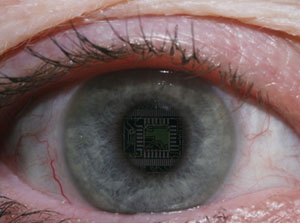 We even hear that machines becoming self-aware is a logical next step, largely a foregone conclusion of the process, and likely the key point of danger. Except,
We even hear that machines becoming self-aware is a logical next step, largely a foregone conclusion of the process, and likely the key point of danger. Except,  It still comes back to a primary function, too: artificial intelligence would have to possess an overriding drive to survive, at the expense of everything else. That’s what even provokes competition in the first place. But here’s the bit that we don’t think about much: it is eminently possible to survive without unchecked expansion, and in fact, this is preferable in many areas, including resource usage and non-increasing competition with other species and long-term sustainability. We don’t have it, because natural selection wasn’t efficient enough to provide it, even though it only takes a moment’s thought to realize it’s a damn sight better than overpopulation and overcompetition. Stability is, literally, ideal. We think that ultra-intelligent machines are somehow likely to commit the same stupid mistakes we do, which is another curious dichotomy.
It still comes back to a primary function, too: artificial intelligence would have to possess an overriding drive to survive, at the expense of everything else. That’s what even provokes competition in the first place. But here’s the bit that we don’t think about much: it is eminently possible to survive without unchecked expansion, and in fact, this is preferable in many areas, including resource usage and non-increasing competition with other species and long-term sustainability. We don’t have it, because natural selection wasn’t efficient enough to provide it, even though it only takes a moment’s thought to realize it’s a damn sight better than overpopulation and overcompetition. Stability is, literally, ideal. We think that ultra-intelligent machines are somehow likely to commit the same stupid mistakes we do, which is another curious dichotomy. The snowstorms that have hit the northeast have completely passed us by here in NC… or had, anyway. Tuesday morning it came in with a vengeance – thick clumps of snowflakes packed together like schoolgirls on the way to the ladies room, but considerably quieter. I ventured out for photos, but had to keep the camera covered with a towel almost the entire time it was in hand. The snow was even piling up on the backs of the Canada geese (Branta canadensis) as they cruised the pond wondering what all the fuss was about. I feel obligated to mention that this is the same pond, though neither likely the same goose, seen in
The snowstorms that have hit the northeast have completely passed us by here in NC… or had, anyway. Tuesday morning it came in with a vengeance – thick clumps of snowflakes packed together like schoolgirls on the way to the ladies room, but considerably quieter. I ventured out for photos, but had to keep the camera covered with a towel almost the entire time it was in hand. The snow was even piling up on the backs of the Canada geese (Branta canadensis) as they cruised the pond wondering what all the fuss was about. I feel obligated to mention that this is the same pond, though neither likely the same goose, seen in 

 Then Wednesday brought surprisingly clear roads, and when I got the chance I scampered out for some pics someplace other than our backyard, but the snow was melting far too quickly. I shot a winter version of the early fall image
Then Wednesday brought surprisingly clear roads, and when I got the chance I scampered out for some pics someplace other than our backyard, but the snow was melting far too quickly. I shot a winter version of the early fall image 
 The weather reports this winter, as I suspect for much of the country, have been highly erratic, their predictions often changing drastically every few days, so while snow was predicted for yesterday evening, it suddenly jumped up to (depending on the source) estimates from 10 to 30 centimeters, or 4-12 inches. It started in mid-evening and got down to business quickly, and I set up the camera alongside the floodlights on the back porch to do a time exposure of the flakes passing through the light beam – I had hoped for some nice swirls of flakes lazily blown by the wind, but what I got instead were streaks of huge and clumped wet flakes hurtling down harder than snow is supposed to; this image is a mere 1/5 second and only what is captured in the light thrown by the bulb glimpsed in the corner, so maybe slightly more than a meter in depth (with the frame spanning about a meter vertically as well.) You can even see one clump spinning in its descent, right in the middle of the frame. Apparently falling a flake at a time was considered inefficient, so they ganged up and came down like parachute display teams.
The weather reports this winter, as I suspect for much of the country, have been highly erratic, their predictions often changing drastically every few days, so while snow was predicted for yesterday evening, it suddenly jumped up to (depending on the source) estimates from 10 to 30 centimeters, or 4-12 inches. It started in mid-evening and got down to business quickly, and I set up the camera alongside the floodlights on the back porch to do a time exposure of the flakes passing through the light beam – I had hoped for some nice swirls of flakes lazily blown by the wind, but what I got instead were streaks of huge and clumped wet flakes hurtling down harder than snow is supposed to; this image is a mere 1/5 second and only what is captured in the light thrown by the bulb glimpsed in the corner, so maybe slightly more than a meter in depth (with the frame spanning about a meter vertically as well.) You can even see one clump spinning in its descent, right in the middle of the frame. Apparently falling a flake at a time was considered inefficient, so they ganged up and came down like parachute display teams.
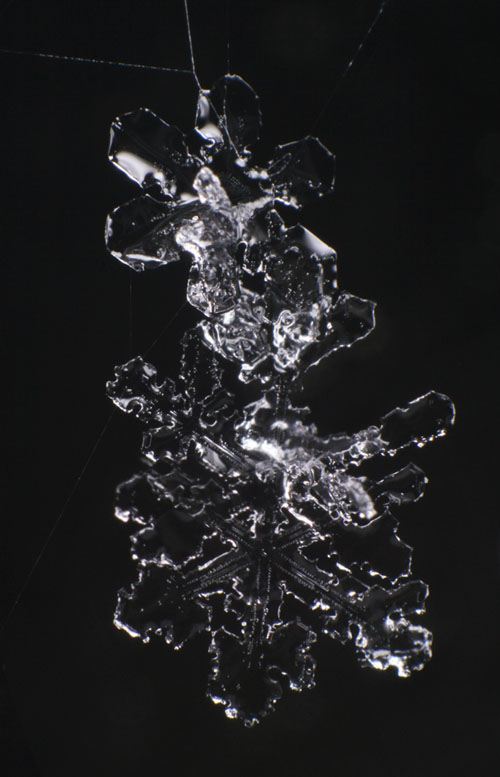 And the same web strands that had been used previously sported these two flakes this time around – I’d really love to find a way to preserve a patch of spider web just for the snows, since it’s so damn useful in supporting flakes like a display stand. Maybe I’ll start raising black widows (which have remarkably strong webbing.) I admit that this is a ‘stacked’ image, actually two combined, since I did not get any frames where both prominent flakes were in tight focus at the same time – where would I be without Photoshop? Well, showing you two images instead of one, I guess…
And the same web strands that had been used previously sported these two flakes this time around – I’d really love to find a way to preserve a patch of spider web just for the snows, since it’s so damn useful in supporting flakes like a display stand. Maybe I’ll start raising black widows (which have remarkably strong webbing.) I admit that this is a ‘stacked’ image, actually two combined, since I did not get any frames where both prominent flakes were in tight focus at the same time – where would I be without Photoshop? Well, showing you two images instead of one, I guess…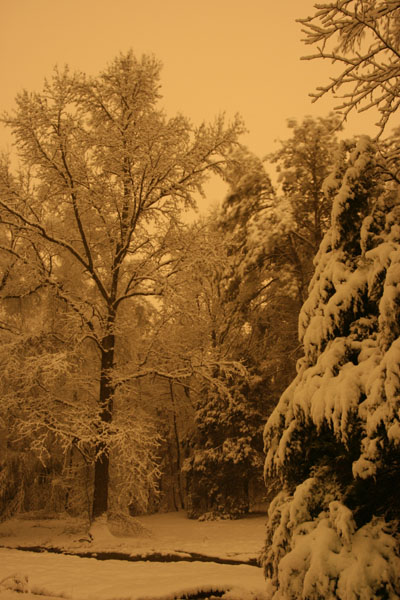 Around 2 AM, as the snowfall had slowed to feeble efforts, I got dressed up again and ventured out in the depths, probably around 13 cm (5 in) of accumulation – again, nothing to compare to the northeast, but a pretty good amount for this area. The trees were all heavily burdened and white, and visibility was surprisingly good because the low overcast bounced the city light back down, to be reflected around by the snow – I could almost adjust the camera settings without additional light. This is a 20-second exposure at f7.1, ISO 250, and only a little brighter than it actually looked while out there. I was rather selective of where I walked, however, because the branches were still coming down, and I don’t think that’s any surprise now with the accompanying image. Indeed, not long after getting this shot and moving on to a different area, I heard a branch break off and thud into the ground, not very close to where I had stood but not far enough from it either, a nice warning.
Around 2 AM, as the snowfall had slowed to feeble efforts, I got dressed up again and ventured out in the depths, probably around 13 cm (5 in) of accumulation – again, nothing to compare to the northeast, but a pretty good amount for this area. The trees were all heavily burdened and white, and visibility was surprisingly good because the low overcast bounced the city light back down, to be reflected around by the snow – I could almost adjust the camera settings without additional light. This is a 20-second exposure at f7.1, ISO 250, and only a little brighter than it actually looked while out there. I was rather selective of where I walked, however, because the branches were still coming down, and I don’t think that’s any surprise now with the accompanying image. Indeed, not long after getting this shot and moving on to a different area, I heard a branch break off and thud into the ground, not very close to where I had stood but not far enough from it either, a nice warning.
 I actually took photos today! But I may get some more tonight, and want to do a longer post, so for now, we go retro.
I actually took photos today! But I may get some more tonight, and want to do a longer post, so for now, we go retro. For this week’s Monday color, we hearken back (not to be confused with harkening back) to 1991 I believe, during a training seminar for animal cruelty investigation being held in Nashville, Tennessee. I had some free time in the evening and was wandering around the downtown area when the sky was suffused with some very rich hues at sunset. Spotting the crescent moon in the sky, I quickly lined up a shot with the Union Station clock tower, braced against a light pole, and snapped the shot.
For this week’s Monday color, we hearken back (not to be confused with harkening back) to 1991 I believe, during a training seminar for animal cruelty investigation being held in Nashville, Tennessee. I had some free time in the evening and was wandering around the downtown area when the sky was suffused with some very rich hues at sunset. Spotting the crescent moon in the sky, I quickly lined up a shot with the Union Station clock tower, braced against a light pole, and snapped the shot.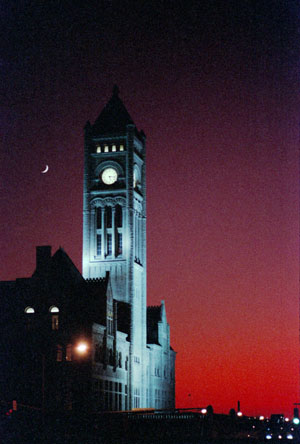 In fact, it looked like this, and even at this reduced size, you can also make out just how grainy it is. The detail is actually pretty impressive when seen at higher magnification, but the color rendition of the sky was ridiculously far off (and convinced me to avoid that film forever thereafter.) As I learned some photo editing skills, I dug out the original negative and rendered the sky the way that I remembered it, making sure I didn’t alter the registers anywhere else, since the rest of the image seemed perfectly appropriate.
In fact, it looked like this, and even at this reduced size, you can also make out just how grainy it is. The detail is actually pretty impressive when seen at higher magnification, but the color rendition of the sky was ridiculously far off (and convinced me to avoid that film forever thereafter.) As I learned some photo editing skills, I dug out the original negative and rendered the sky the way that I remembered it, making sure I didn’t alter the registers anywhere else, since the rest of the image seemed perfectly appropriate.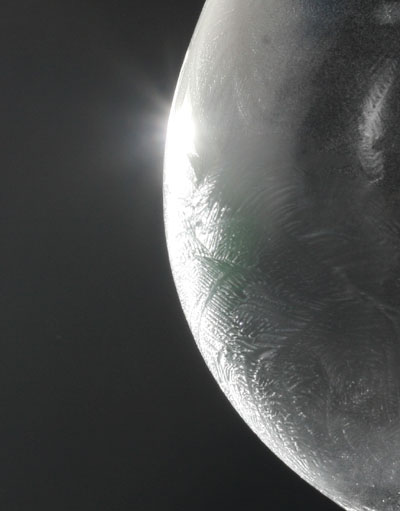 As
As 
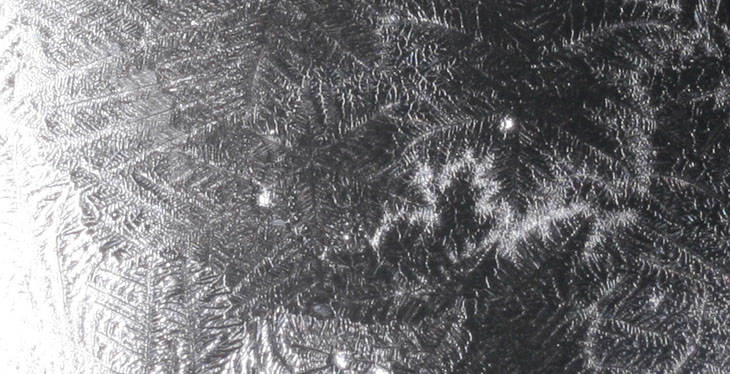

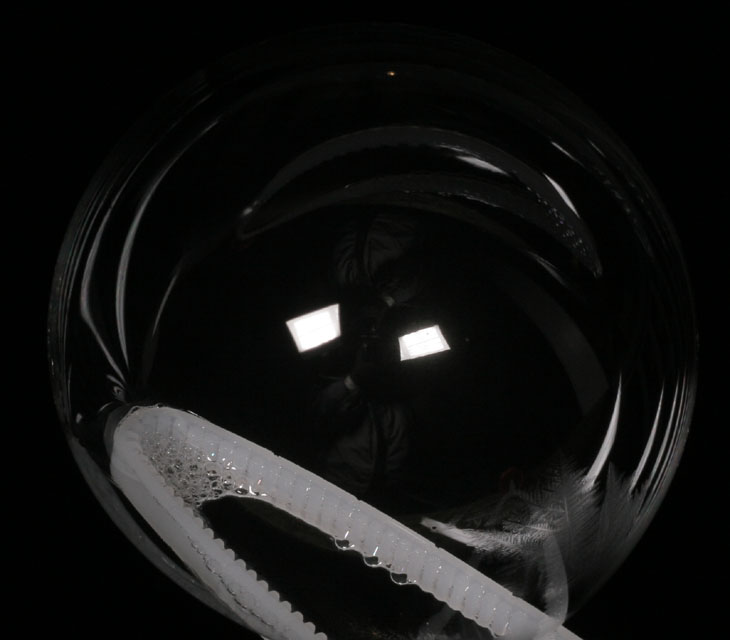
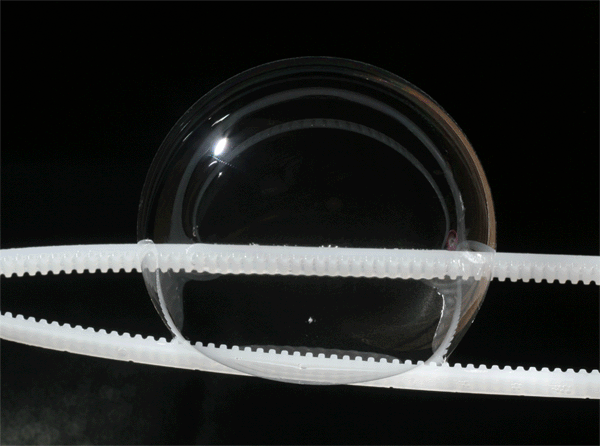
 I have a lot of purple in the ‘color’ folder, so I’m trying to space them out adequately, but I suppose they’ll be spaced out with other photos as we go anyway.
I have a lot of purple in the ‘color’ folder, so I’m trying to space them out adequately, but I suppose they’ll be spaced out with other photos as we go anyway.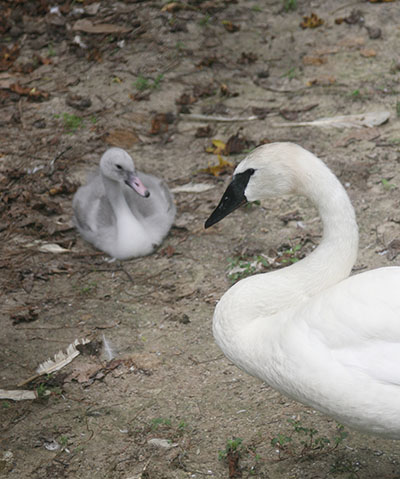 So, in a post on August 10 of last year, and again on August 13, I mentioned a trip that we’d taken that I was going to feature “shortly.” Given that there is no firm definition of this word, I maintain that I still made this deadline.
So, in a post on August 10 of last year, and again on August 13, I mentioned a trip that we’d taken that I was going to feature “shortly.” Given that there is no firm definition of this word, I maintain that I still made this deadline.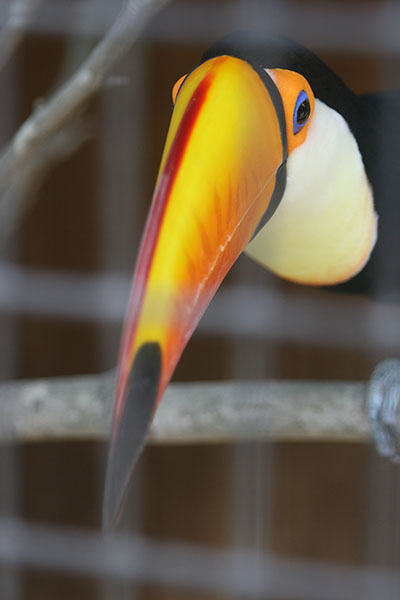 Then there’s one of the prime reasons why captive photography in zoos and parks often doesn’t work as well as imagined: fences. And, to a lesser extend, glass, and the enclosures behind the animals as well. Getting a nice image without any of these distracting, telltale traits in it can be challenging, but I will (with extreme reluctance) admit that this is one place where smutphone cameras can be useful. A typical SLR [read: proper] camera lens is wider than the gaps in the fencing, so they’re going to show no matter what, but the tiny lens on a phone camera can easily shoot through the openings. Now all you have to worry about is non-selective focus, no control over depth of field, automatic exposure control that somehow thinks 12800 ISO will produce usable images, and so on. But the fence will be out of the shot! Also, there’s a chance that badasses like this toco toucan (Ramphastos toco) will slip a beak through and take your phone away…
Then there’s one of the prime reasons why captive photography in zoos and parks often doesn’t work as well as imagined: fences. And, to a lesser extend, glass, and the enclosures behind the animals as well. Getting a nice image without any of these distracting, telltale traits in it can be challenging, but I will (with extreme reluctance) admit that this is one place where smutphone cameras can be useful. A typical SLR [read: proper] camera lens is wider than the gaps in the fencing, so they’re going to show no matter what, but the tiny lens on a phone camera can easily shoot through the openings. Now all you have to worry about is non-selective focus, no control over depth of field, automatic exposure control that somehow thinks 12800 ISO will produce usable images, and so on. But the fence will be out of the shot! Also, there’s a chance that badasses like this toco toucan (Ramphastos toco) will slip a beak through and take your phone away… So, another fence shot – seriously, I got less than half of the useful images I’d intended. The only reason I’m featuring this whooping crane (Grus americana) is to show something I’d never realized: the red spot atop the head isn’t feathers, but actually a (mostly) bald spot, and it’s true for the similar sandhill cranes as well – I’ve photographed those numerous times and never noticed, but I suspect you have to be really close. The light angle wasn’t very useful for a better portrait either, with no opportunity to pick another, and had I used a fill-flash to get light into those shadows, it would have illuminated the fence far worse – the best I could have done was to have someone else hold the flash off-camera and away from the fence, and it really wasn’t worth the effort (now you’re starting to see why I didn’t rush this post up, aren’t you?) This particular crane was quite happily greeting visitors, though whether it was in the hopes of a handout, or to protect its territory, or because it was nearsighted and thought we were potential mates, I cannot confirm. But it’s one of the few birds where I got a usable audio recording as it grunted softly; one of the people I was there with was engaged in this conversation, so that’s the other voice you hear.
So, another fence shot – seriously, I got less than half of the useful images I’d intended. The only reason I’m featuring this whooping crane (Grus americana) is to show something I’d never realized: the red spot atop the head isn’t feathers, but actually a (mostly) bald spot, and it’s true for the similar sandhill cranes as well – I’ve photographed those numerous times and never noticed, but I suspect you have to be really close. The light angle wasn’t very useful for a better portrait either, with no opportunity to pick another, and had I used a fill-flash to get light into those shadows, it would have illuminated the fence far worse – the best I could have done was to have someone else hold the flash off-camera and away from the fence, and it really wasn’t worth the effort (now you’re starting to see why I didn’t rush this post up, aren’t you?) This particular crane was quite happily greeting visitors, though whether it was in the hopes of a handout, or to protect its territory, or because it was nearsighted and thought we were potential mates, I cannot confirm. But it’s one of the few birds where I got a usable audio recording as it grunted softly; one of the people I was there with was engaged in this conversation, so that’s the other voice you hear. In a lot of the enclosures within the park, numerous species were all housed together, and in fact visitors are free to enter many of them, separated from the avians by only a low railing (that the birds occasionally disregarded themselves.) Guests gained access through gates that kept the birds within, and vast stretches of netting overhead completed the enclosure, as well as maintaining a barrier to local predators – we observed an opportunistic but frustrated coopers hawk, a native bird-eating species, make an attempt at one of the residents only to be thwarted by the netting.
In a lot of the enclosures within the park, numerous species were all housed together, and in fact visitors are free to enter many of them, separated from the avians by only a low railing (that the birds occasionally disregarded themselves.) Guests gained access through gates that kept the birds within, and vast stretches of netting overhead completed the enclosure, as well as maintaining a barrier to local predators – we observed an opportunistic but frustrated coopers hawk, a native bird-eating species, make an attempt at one of the residents only to be thwarted by the netting.
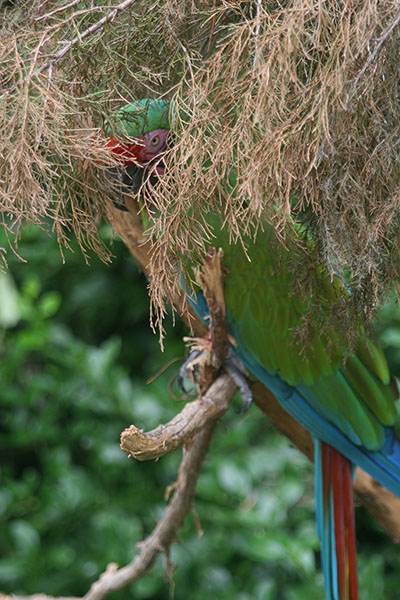 Somehow, just about every image I got is oriented to the left, meaning they need to sit to the right of the text, preventing much variety in the post layout – another reason I held off on this one, but now I’ll just make you suffer over it (I can picture hundreds of readers clawing at their eyes crying, “The repetition! The repetition!” – but then I’m weird, I think we’ve agreed before.) This great green macaw (Ara ambiguus) seemed quite pleased with itself deep in the foliage, and I kept shifting slightly to keep one eye in view, just to maintain a focal point – it’s at least a little better than a straightforward portrait. Unfortunately, I would greatly prefer to have gotten more shots of species people don’t often see, over something usually found hanging out at the local pet store. For some reason, I never even spotted a mandarin duck, which you should definitely look up – perhaps the most gorgeously-colored bird that I know of. There’s one that lives at
Somehow, just about every image I got is oriented to the left, meaning they need to sit to the right of the text, preventing much variety in the post layout – another reason I held off on this one, but now I’ll just make you suffer over it (I can picture hundreds of readers clawing at their eyes crying, “The repetition! The repetition!” – but then I’m weird, I think we’ve agreed before.) This great green macaw (Ara ambiguus) seemed quite pleased with itself deep in the foliage, and I kept shifting slightly to keep one eye in view, just to maintain a focal point – it’s at least a little better than a straightforward portrait. Unfortunately, I would greatly prefer to have gotten more shots of species people don’t often see, over something usually found hanging out at the local pet store. For some reason, I never even spotted a mandarin duck, which you should definitely look up – perhaps the most gorgeously-colored bird that I know of. There’s one that lives at  From a hanging basket alongside the path dangled a collection of delicate pink flowers, and as I went in close for a detail shot, I spotted this occupant, prompting me to get the flash out. I’m not going to try identifying it, but I can tell you it could fit comfortably on your pinky fingernail. The sparkle from the flower petals isn’t dew, or really anything particular to this species – it can be seen on a lot of flowers, but you have to be looking really closely. At an average viewing distance it usually can’t be made out very well. The results would certainly have been better with the softbox attachment, but I hadn’t planned on doing any dedicated macro work and so hadn’t brought the equipment I typically use for that – I know, right? How can I call myself a photographer? Believe me, it was a struggle to even admit this to you, but my therapist tells me it’s good to get it out in the open. Plus there’s all that stuff that I never tell anyone…
From a hanging basket alongside the path dangled a collection of delicate pink flowers, and as I went in close for a detail shot, I spotted this occupant, prompting me to get the flash out. I’m not going to try identifying it, but I can tell you it could fit comfortably on your pinky fingernail. The sparkle from the flower petals isn’t dew, or really anything particular to this species – it can be seen on a lot of flowers, but you have to be looking really closely. At an average viewing distance it usually can’t be made out very well. The results would certainly have been better with the softbox attachment, but I hadn’t planned on doing any dedicated macro work and so hadn’t brought the equipment I typically use for that – I know, right? How can I call myself a photographer? Believe me, it was a struggle to even admit this to you, but my therapist tells me it’s good to get it out in the open. Plus there’s all that stuff that I never tell anyone…